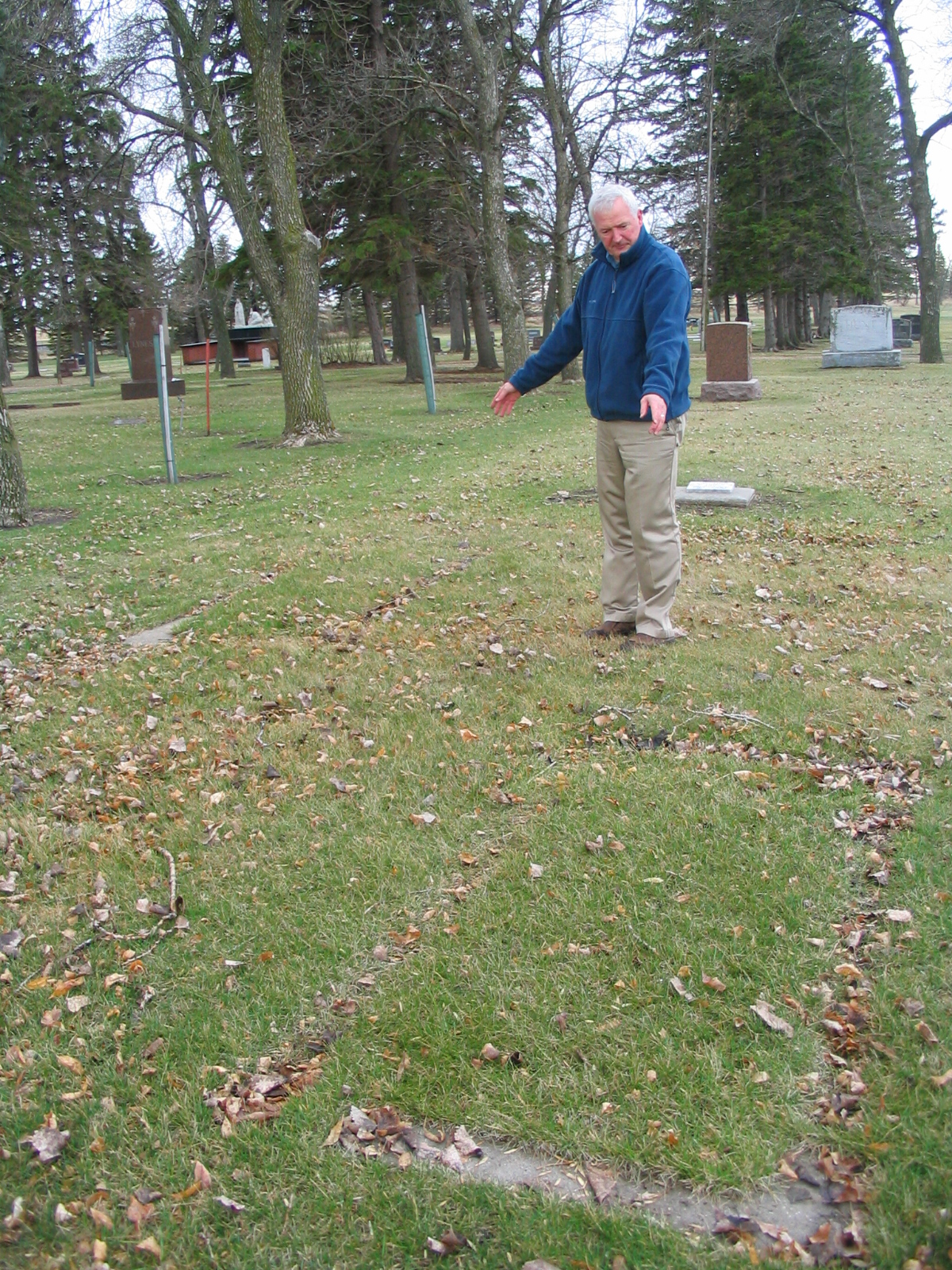Frederick Schlechter died at ripe old age: father of F. W. and J. H. Schlechter, quietly passed away last Thursday. After a residence here since 1894. John Frederick Schlechter, aged 80, died at the home of his son, Friedrich W. Schlechter, Thursday morning, May 15, 1913. Death was due to old age. Deceased leaves to mourn his loss, three sons, Jacob H. and Friedrich W. of this city, and Emanuel E. Schlechter of Anamoose, and one daughter, Friedrika, Mrs. Jacob Redmann of Wessington Springs, SD. All were here to attend the funeral, which was held Saturday afternoon from the First Congregational church. Interment was made in the local cemetery. John Friedrich Schlechter was born November 17, 1832 in the village of Murr, near Marback Wurtemberg, Germany. When eight years of age, his parents emigrated to the village of Plotzk, Province of Bessarabia, in southern Russia, where he resided until 1878. He was joined in the bonds of holy matrimony with Miss Friedericka Wehr on January 29, 1858; this union was blessed with ten children, six of whom preceded him in death.
Beginning in the 1760's and continuing for more than a century, German farmers and artisans migrated to Russia in numbers totaling more than 100,000. These people longed to escape from the economic difficulties of the disastrous Seven Years' War and from sometime religious persecution. Catherine the Great issued a manifesto in 1763 that made alluring promises to all foreigners "regardless of nationality and religion" who would settle the uninhabited regions of Russia. From the first generation on the Russian steppe, carving out the new farms and villages was a harsh, often bitter experience. But hard work was a fact of life for them, and they were a persevering people, industrious much beyond the ordinary. Within a short time they had established thriving agriculture-based colonies. What makes the history of these people unique is that in each new settlement they retained their German culture and way of life. Ultimately, the insistence on retaining their strong ethnic identity left the Russian Germans vulnerable to new troubles. Promises made in the original Russian manifestos were withdrawn, harassment and persecution became widespread. Once again, emigration was the response. From the 1870s into the early twentieth century, thousands of these Germans in Russia left for a new promised land. For most, this meant starting again on the plains of the Americas where, like their forefathers, they began the hard task of being pioneers in a strange new country. And, once again, agriculture was the way of life for the majority, although many settled in cities, also. The hard, backbreaking work was still accepted. The sense of being different was still present. The dream of building a better life was still the strong motivator at home, in church and at work. This time, however, there was a difference. This time these families were finally able to realize their dream. Most of them were able to establish a comfortable way of life for themselves far beyond their basic hopes for freedom from hunger, persecution and fear. Today their descendants can look back in admiration at the accomplishments of their forefathers who were the Germans from Russia.
Three sons of Friedrich (1800-1849) and Friederika (1802-1876), nee Koch, Schlechter, from Murr, Germany via Plotzk, Bessarabia, Russia, decided to immigrate to the New World; namely: Johann Friedrich (1832-1913), Gottfried (1838-1917) and Johann Jacob (1841-1919) Schlechter. Johann Frederick and Friedrika (Wehr) Schlechter and their seven children arrived at New York from Bremen, Germany on November 29, 1878 aboard the Rhein. Gottfried and Elizabeth (Hoehn) Schlechter and their seven children arrived at New York from Bremen, Germany on November 8, 1879 aboard the Neckar. Johann Jacob and Magdalena (Bahnmueller) Schlechter and their six children arrived at New York from Bremen, Germany on November 12, 1880 aboard the Rhein. The families settled in North and South Dakota, where many of their descendants remain (Oshkosh Northwestern Newspaper).
The 1880 census shows Johann, Friedrika with children Gottfried, Friedrich, Jacob, Friedrika, Magdalena and Emanuel living in Hutchinson County, South Dakota. The 1900 census shows Johann, Friedrika, Gottfried, Friedrich and Jacob living in Oshkosh, North Dakota.
The Schlechter brothers: Johann F. Schlechter: memorial #83121984; Gottfried Schlechter: memorial #13399187 and Johann Jacob Schlechter: memorial #35518588.
Frederick Schlechter died at ripe old age: father of F. W. and J. H. Schlechter, quietly passed away last Thursday. After a residence here since 1894. John Frederick Schlechter, aged 80, died at the home of his son, Friedrich W. Schlechter, Thursday morning, May 15, 1913. Death was due to old age. Deceased leaves to mourn his loss, three sons, Jacob H. and Friedrich W. of this city, and Emanuel E. Schlechter of Anamoose, and one daughter, Friedrika, Mrs. Jacob Redmann of Wessington Springs, SD. All were here to attend the funeral, which was held Saturday afternoon from the First Congregational church. Interment was made in the local cemetery. John Friedrich Schlechter was born November 17, 1832 in the village of Murr, near Marback Wurtemberg, Germany. When eight years of age, his parents emigrated to the village of Plotzk, Province of Bessarabia, in southern Russia, where he resided until 1878. He was joined in the bonds of holy matrimony with Miss Friedericka Wehr on January 29, 1858; this union was blessed with ten children, six of whom preceded him in death.
Beginning in the 1760's and continuing for more than a century, German farmers and artisans migrated to Russia in numbers totaling more than 100,000. These people longed to escape from the economic difficulties of the disastrous Seven Years' War and from sometime religious persecution. Catherine the Great issued a manifesto in 1763 that made alluring promises to all foreigners "regardless of nationality and religion" who would settle the uninhabited regions of Russia. From the first generation on the Russian steppe, carving out the new farms and villages was a harsh, often bitter experience. But hard work was a fact of life for them, and they were a persevering people, industrious much beyond the ordinary. Within a short time they had established thriving agriculture-based colonies. What makes the history of these people unique is that in each new settlement they retained their German culture and way of life. Ultimately, the insistence on retaining their strong ethnic identity left the Russian Germans vulnerable to new troubles. Promises made in the original Russian manifestos were withdrawn, harassment and persecution became widespread. Once again, emigration was the response. From the 1870s into the early twentieth century, thousands of these Germans in Russia left for a new promised land. For most, this meant starting again on the plains of the Americas where, like their forefathers, they began the hard task of being pioneers in a strange new country. And, once again, agriculture was the way of life for the majority, although many settled in cities, also. The hard, backbreaking work was still accepted. The sense of being different was still present. The dream of building a better life was still the strong motivator at home, in church and at work. This time, however, there was a difference. This time these families were finally able to realize their dream. Most of them were able to establish a comfortable way of life for themselves far beyond their basic hopes for freedom from hunger, persecution and fear. Today their descendants can look back in admiration at the accomplishments of their forefathers who were the Germans from Russia.
Three sons of Friedrich (1800-1849) and Friederika (1802-1876), nee Koch, Schlechter, from Murr, Germany via Plotzk, Bessarabia, Russia, decided to immigrate to the New World; namely: Johann Friedrich (1832-1913), Gottfried (1838-1917) and Johann Jacob (1841-1919) Schlechter. Johann Frederick and Friedrika (Wehr) Schlechter and their seven children arrived at New York from Bremen, Germany on November 29, 1878 aboard the Rhein. Gottfried and Elizabeth (Hoehn) Schlechter and their seven children arrived at New York from Bremen, Germany on November 8, 1879 aboard the Neckar. Johann Jacob and Magdalena (Bahnmueller) Schlechter and their six children arrived at New York from Bremen, Germany on November 12, 1880 aboard the Rhein. The families settled in North and South Dakota, where many of their descendants remain (Oshkosh Northwestern Newspaper).
The 1880 census shows Johann, Friedrika with children Gottfried, Friedrich, Jacob, Friedrika, Magdalena and Emanuel living in Hutchinson County, South Dakota. The 1900 census shows Johann, Friedrika, Gottfried, Friedrich and Jacob living in Oshkosh, North Dakota.
The Schlechter brothers: Johann F. Schlechter: memorial #83121984; Gottfried Schlechter: memorial #13399187 and Johann Jacob Schlechter: memorial #35518588.
Family Members
Sponsored by Ancestry
Advertisement
Advertisement

















